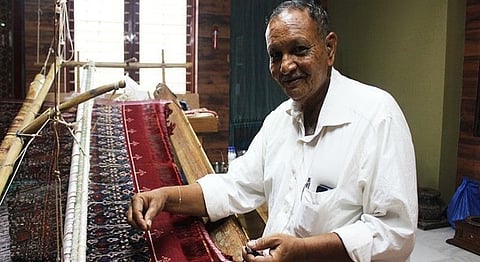
- HOMEGROWN WORLD
- #HGCREATORS
- #HGEXPLORE
- #HGVOICES
- #HGSHOP
- CAREERS
- ABOUT US
- CONTACT US

I was standing amidst the massive subterranean structure of Rani-Ki-Vav (Queen’s Stepwell) in Patan, Gujarat when I first noticed it. My eyes were lingering through the 500 principle structures and over a thousand minor ones of the human figurines, gods and goddesses carved on this World Heritage Site, when suddenly they got fixated upon unique but familiar abstract designs sculpted on the musty wall panels. These were geometric patterns and shapes carved very intricately, one inside the other. I was intrigued. Most of the carvings on the walls of the 7 storied Rani-Ki-Vav were religious and mythological in nature and we had been told the significance of most of these. But these abstract patterns were something I could not decipher.
Following my gaze, the guide told me that these were, in fact, the designs of the ‘Patola Sarees’. Patan is apparently the home to the lavish Patan Patola sarees. “There is a Patan Patola Saree Making Unit, just down the street,” he told me. “There, you can talk to Mr. Salvi, the master weaver. His is one of the only families continuing the tradition of Patola making,” he added. I didn’t need further convincing
I walked into the Patan Patola Saree Unit and heritage museum. There was nothing grand about the exteriors for it looked just like one of the colourful bungalows that lined the lanes of Patan. But as I entered, I was baffled by the first site that greeted me: a huge bamboo structure, a hand operated harness loom of sorts, a wooden stool and a few tools kept on the side. I spotted an old, stout man approaching. He introduced himself as Mr. Salvi, a Patola Saree maker and the owner of the museum. Mr. Salvi’s is the 6th generation of one of the only two families to continue with the family guarded tradition of Patola Saree-making, amongst the 700 weaver families who migrated from Maharashtra to Patan in the 11th century. With his excited yet humble demeanor, he took me through the history, the legacy and the process of making the Patan Patola.
Considered by many, as the ‘ultimate manifestation of weaving perfection,’ the making of the Patola sarees is a complex, creative process that requires vivid imagination as well as mathematical precision. Amply used as precious gifts in the 17th and the 18th century, the glorious history of the Patan Patola has been documented by various travellers who visited the ancient capital of Gujarat. The tradition of Patola sarees is 800 years old, and the Salvis have been practicing it ever since. These Sarees, with designs varying from geometrical patterns to birds, animals and even abstract figures are made of silk and have a double ikat weave, which is a combination of different techniques of tying, dyeing and weaving. The warp and the weft silk threads are treated, tied and dyed separately and are colored in different hues as conceptualized by the weaver. The warp threads are then put together in a sequence so that the design becomes evident. The displacement of even one thread can deform and destroy the whole design, so it requires extreme precision.
“It is a very intricate and a time-consuming process. One Patola takes at least 6 months to be ready,” stated Mr. Salvi, showing me a beautiful green Patola Saree and telling me how the double ikat ensures that the colours never fade out. The cost of one Patola Saree ranges from a lakh to a few lakhs depending on the time and efforts involved.
He then took me through the heritage museum showing us the various tools and equipment used. The walls are lined with black and white photographs of the Salvi family’s ancestors shown weaving the Patola. Another wall has pictures of him posing with eminent personalities like Amitabh Bachchan, Sonia Gandhi, Dipti Naval acknowledging his efforts as a Patola Saree maker, followed by the accolades he has won and the live demonstration of the making of Patola in many countries such as Canada, the United States, parts of Europe etc. There is also an entire exhibit that showcases cloth materials and double ikat weaves from other parts of the world. He explains each one to us, drawing parallels between them. That day, my friends and I seem to be the only visitors; but I am told that the museum sees almost a hundred visitors every day.
The dynamics of this centuries old tradition have been aptly captured in this opulent Patola Heritage Museum; its heirloom being preserved as a prized possession by the Salvi family, so that the legacy will continue. Overwhelmed by one family’s tryst on making the Patola survive, we step out.
Buzzing through the dusty streets, past the hued shut wooden doors, and the hundreds of Jain temples that Patan is famous for, we decide to escape the chaos of the small town, to come to a serene water body, just on the outskirts, called Khan Sarovar; a water reservoir constructed in the late 19th century using stones from ruined structures, by Khan Mirza Aziz Kokah, the then-governor of Gujarat. It is late afternoon, and I could hear loud music blaring from almost every rooftop. I look up to see a sky full of colorful kites, that remind me of the multitude of colours and the designs of the Patola. It is apparently, Uttrayan, the kite festival in Gujarat and the celebrations are in full swing. A little boy bumps into me while running after a kite that he had just cut. Smiling coyly, he mutters an apology. His smile serves as the perfect metaphor for the small, culturally rich town of Patan and its famous Patola – amazing, innocent and modest, perhaps Gujarat’s best kept secret.
If you enjoyed reading this article, we suggest you read:
